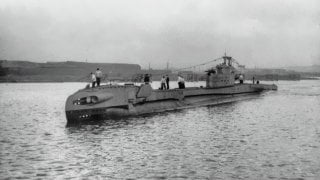A Royal Navy Submarine 'Struck an Oil Tanker' and Went to the Bottom
On January 12, 1950, the British Royal Navy submarine HMS Truculent sank after colliding with the Swedish oil tanker Dvina in the Thames Estuary. Returning from post-refit trials with 59 crew members and 18 civilian technicians aboard, the submarine mistakenly believed the approaching tanker was stationary.
What You Need to Know: On January 12, 1950, the British Royal Navy submarine HMS Truculent sank after colliding with the Swedish oil tanker Dvina in the Thames Estuary. Returning from post-refit trials with 59 crew members and 18 civilian technicians aboard, the submarine mistakenly believed the approaching tanker was stationary.
-The collision caused HMS Truculent to sink rapidly. While 67 individuals made a near-perfect escape from the vessel, only 11 survived due to freezing temperatures and strong tides.
-The tragedy led to significant changes in submarine safety protocols, including the introduction of the "Truculent light," an additional white light on the bow of British submarines to prevent similar accidents.
The Tragedy of HMS Truculent
The UK's Royal Navy was an early pioneer in submarine warfare, and tragically has seen a number of deadly mishaps with the undersea vessels. Among the worst in the Royal Navy's history was that of HMS Truculent, a T-class submarine that sank following a collision in early 1950. Though most of everyone on board was able to escape the boat, only 11 survived on the surface.
The World War II-era boat had been launched in September 1942 and went on to sink nine enemy vessels during the conflict. However, on the evening of January 12, 1950, while carrying out trials off the Thames Estuary following a refit at the Chatham dockyard, the boat was struck by the Swedish oil tanker Dvina.
The tragedy was made worse as in addition to the crew of 59 sailors, the submarine was carrying 18 civilian dockyard technicians who were running tests and conducting final performance reviews before HMS Truculent could be officially handed back to the Royal Navy. At approximately 19:00 hours (7 pm), the submarine spotted the tanker, which was believed to be stationary.
That was not the case, and the submarine began to pass the Swedish ship on the port side when the two vessels collided. HMS Truculent quickly began to sink, and 67 of the men onboard made what was described as a "near-perfect" escape from the submarine. However, the majority were swept away by the tide or died in the freezing water. Around 15 men were rescued by Dvina, while another five were picked out of the water by the Dutch freighter Almdijk . Only 11 survived.
At the subsequent inquiry, it was determined that had the men remained inside the submarine longer – for 20 to 30 minutes – until rescue ships deployed under the Royal Navy's "Subsunk alert," many could have been saved. However, it has also been pointed out that those on board could succumb to carbon dioxide poisoning as a result of flooding and after-compartments being closed. The boat's first officer made a snap decision, and it called for the evacuation of the doomed submarine.
HMS Truculent was salvaged on March 14, 1950, and beached at Cheney Spit. The wreck was then moved inshore and 10 additional men were discovered dead onboard.
The inquiry attributed the primary blame to HMS Truculent and to a lesser extent on Dvina. The loss of the submarine also led to the introduction of the "Truculent light," an extra steaming all-round white light that is on the bow of British submarines. It was also determined that had the crew and technicians been wearing immersion suits more would have likely survived the time in the cold water and the automatic flashing lights fitted to the suit would have made them easier to spot at night.
A memorial to those lost in the accident is present in Chatham, Kent, UK.
Author Experience and Expertise: Peter Suciu
Peter Suciu is a Michigan-based writer. He has contributed to more than four dozen magazines, newspapers, and websites with over 3,200 published pieces over a twenty-year career in journalism. He regularly writes about military hardware, firearms history, cybersecurity, politics, and international affairs. Peter is also a Contributing Writer for Forbes and Clearance Jobs. You can follow him on Twitter: @PeterSuciu. You can email the author: [email protected].
Image Credit: Creative Commons.


